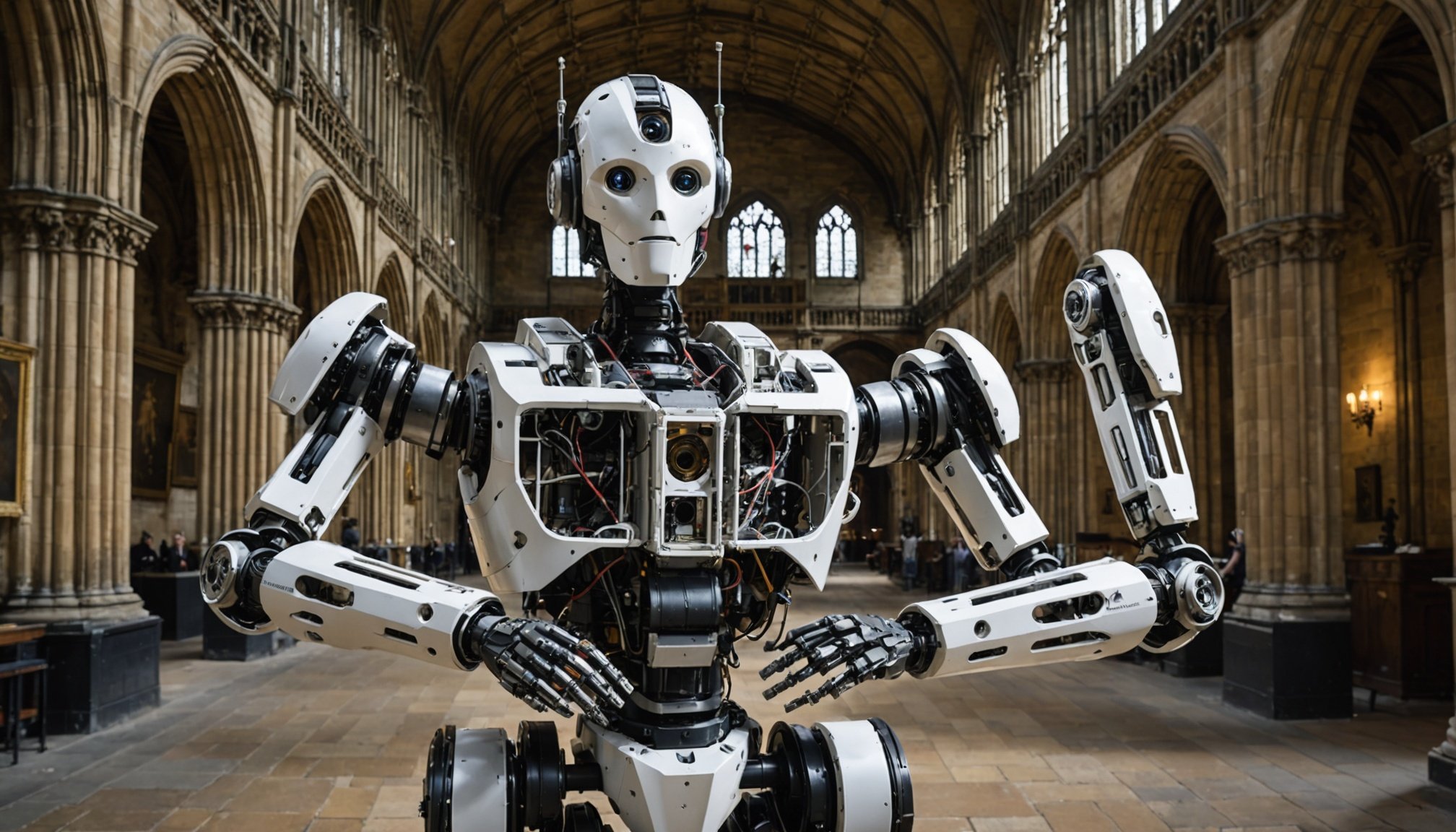Reimagining History: The Impact of Cutting-Edge Robotics on Restoring UK’s Historic Landmarks
The Role of Robotics in Historic Preservation
The preservation of historic landmarks is a delicate and complex task that has been revolutionized by the integration of cutting-edge robotics and advanced technologies. In the UK, where historical sites are plentiful and deeply valued, the use of robotics has become a crucial tool in the restoration and conservation of these cultural treasures.
Drones and Aerial Surveys
One of the most significant contributions of robotics in historic preservation is the use of drones equipped with high-resolution cameras and sensors. These unmanned aerial vehicles (UAVs) can capture detailed images and data from angles and heights that would be impossible or unsafe for human surveyors. For instance, during the restoration of Notre Dame Cathedral in Paris, drones played a pivotal role in assessing the damage and monitoring the progress of the restoration work[1].
Topic to read : Elevate your organization with effective knowledge management
- Capture high-resolution images and videos
- Conduct thermal and infrared scans
- Monitor structural integrity in real-time
- Reduce the need for scaffolding and manual surveys
- Enhance safety by avoiding hazardous areas
Robotic Intervention and Firefighting
Robots like “Colossus,” a remote-controlled heavy firefighting robot, have demonstrated their potential in emergency situations. During the Notre Dame fire, “Colossus” was able to enter the burning building and extinguish fires in areas inaccessible to firefighters. This technology is not only limited to firefighting but can also be used for various other interventions, such as inspecting and repairing structural elements[1].
- Enter hazardous areas inaccessible to humans
- Carry out firefighting operations with precision
- Inspect and repair structural elements
- Reduce risk to human life during emergencies
Digital Twins and 3D Modelling
The concept of “digital twins” has transformed the way historic landmarks are restored. A digital twin is a 3D projection of the building, combining data from before, during, and after the restoration process. This technology was instrumental in the restoration of Notre Dame, allowing architects and engineers to recreate the original structure with high accuracy.
Also to read : Transforming sports coaching: the game-changing impact of augmented reality on real-time performance
Creating a Digital Twin
Livio De Luca, who led the digital restoration team for Notre Dame, explained the process: “We combined data showing the cathedral before the fire, after the fire, and during the restoration.” This model included detailed information on the building’s shape, materials, and structural performance, as well as scientific research conducted on the cathedral over the years[1].
| Aspect | Description |
|---|---|
| Data Integration | Combines pre-fire, post-fire, and restoration data |
| Material Analysis | Detailed information on materials used in the original construction |
| Structural Performance | Analysis of the building’s structural integrity and static performances |
| Scientific Research | Incorporates all scientific research conducted on the cathedral |
| Real-Time Monitoring | Provides real-time data on the building’s condition during restoration |
Benefits of Digital Twins
Digital twins offer several benefits, including:
- Accuracy: Allows for precise reconstruction of historical details.
- Efficiency: Streamlines the restoration process by providing real-time data.
- Safety: Enables timely interventions to prevent further damage.
- Preservation: Helps in maintaining the original appearance and integrity of the building.
Artificial Intelligence in Restoration
Artificial intelligence (AI) has become a vital tool in the restoration of historic landmarks. AI algorithms can analyze vast amounts of data, including historical archives and physical remains, to reconstruct damaged or destroyed elements.
Reconstructing Archival Details
In the case of Notre Dame, AI was used to reconstruct the arches that were destroyed in the fire. By analyzing the remains of the arches and historical data, AI provided a detailed picture of what the arches originally looked like, down to the smallest detail[1].
- Analyze historical archives and physical remains
- Reconstruct damaged or destroyed elements
- Match original materials and textures
- Improve structural integrity based on historical data
Industrial Revolution and Heritage Conservation
The fourth industrial revolution, characterized by the widespread adoption of digital technologies, has significantly impacted heritage conservation. Traditional conservation practices are being replaced by digital methods that offer greater precision, efficiency, and safety.
Digital Reality Capture
Technologies such as laser scanning and photogrammetry are now commonly used for on-site surveys. These methods replace traditional hand-drawn surveys, enabling rapid data acquisition and sharing. Drones, for instance, can capture rich and detailed survey data without the need for scaffolding, making the process safer and more cost-effective[2].
| Traditional Methods | Digital Methods |
|---|---|
| Hand-drawn surveys | Laser scanning and photogrammetry |
| Manual data logging | Automated data collection and analysis |
| Limited interoperability | Enhanced interoperability and real-time data sharing |
| Safety risks | Reduced safety risks through drone and robotic interventions |
Case Studies and Practical Insights
The Restoration of Notre Dame
The restoration of Notre Dame Cathedral is a prime example of how cutting-edge robotics and digital technologies can be applied to historic preservation. The project involved over a thousand experts, engineers, technicians, and restorers who utilized drones, digital twins, and AI to restore the cathedral to its original glory.
- **Interdisciplinary Approach**: Collaboration between global science and engineering communities.
- **Digital Archives**: Use of historical references and archives to recreate original details.
- **Real-Time Monitoring**: Continuous monitoring of the building's structural integrity.
- **Global Solidarity**: International cooperation and knowledge sharing.
Local Treasures in Scotland
In Scotland, UK government funding has been instrumental in saving local historic landmarks. For example, the Community Ownership Fund has provided millions of pounds to restore community centers, historic halls, and other local treasures. These projects not only preserve cultural heritage but also support local economies and community pride[4].
- **Community Engagement**: Involvement of local communities in restoration projects.
- **Economic Impact**: Boost to local economies through tourism and community activities.
- **Cultural Preservation**: Protection of historic buildings and cultural landmarks.
- **Government Support**: Funding and resources provided by the UK government.
Future Perspectives and Challenges
As technology continues to evolve, the potential for robotics and AI in historic preservation is vast. However, there are also challenges to consider, such as the philosophical concerns related to authenticity and the preservation of traditional craft skills.
Balancing Technology and Tradition
The use of advanced technologies like CNC cutting and 3D printing raises questions about the authenticity of the restored structures. While these technologies offer cost-effective solutions, they must be balanced with the need to preserve traditional craft skills and maintain the original character of the buildings[2].
- **Authenticity**: Ensuring that restored structures maintain their original character.
- **Traditional Skills**: Preserving traditional craft skills alongside modern technologies.
- **Cost-Effectiveness**: Balancing the use of advanced technologies with budget constraints.
- **Community Involvement**: Engaging local communities in the decision-making process.
The integration of cutting-edge robotics and digital technologies has revolutionized the field of historic preservation in the UK. From drones and digital twins to AI and industrial revolution technologies, these innovations have enhanced the accuracy, efficiency, and safety of restoration projects. As we move forward, it is crucial to balance technological advancements with the preservation of traditional skills and the authenticity of our cultural heritage.
In the words of Rev. Olivier Ribadeau Dumas, the rector of Notre Dame, “No one alive has seen the cathedral like this. It is more than restored—it is reborn.” This sentiment encapsulates the transformative power of technology in preserving our historical treasures for future generations.
Practical Advice for Restoration Projects
For those involved in restoration projects, here are some practical insights:
- Collaborate with Experts: Engage with a diverse team of experts, including architects, engineers, historians, and local community members.
- Utilize Digital Tools: Leverage digital technologies such as drones, digital twins, and AI to enhance accuracy and efficiency.
- Monitor Real-Time Data: Implement real-time monitoring systems to ensure the structural integrity of the building during restoration.
- Preserve Traditional Skills: Balance modern technologies with the preservation of traditional craft skills.
- Engage the Community: Involve local communities in the decision-making process to ensure that the restored landmark reflects their cultural heritage.
By adopting these strategies, we can ensure that our historic landmarks are not only preserved but also reborn for the world to appreciate.











